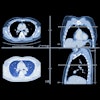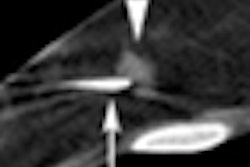A new study of more than 20,000 screening-age individuals in Texas found that health insurance coverage and regular doctor visits were the main drivers of colorectal cancer screening, which remained dismally low overall in a community-based healthcare system.
What's more, if screening compliance were to increase to levels recommended by the U.S. Multisociety Task Force on Colorectal Cancer, the healthcare system would be seriously strained without a substantial influx of resources, the authors warned. More than half of those who completed screening in the study underwent a single fecal occult blood test (FOBT). Even if all eligible individuals underwent the cheapest option, FOBT, just following up positive results would require an eightfold increase in the number of combined colonoscopies, sigmoidoscopies, and barium enemas performed.
As for participation, screening compliance was worst among those without regular health insurance, and, overall, just 22% of the population had been screened in the past five years, even though all of the individuals could have accessed a community healthcare network committed to caring for the poor and uninsured.
Colorectal cancer is the leading cause of cancer death in the U.S., responsible for nearly 50,000 deaths per year. But compliance with screening guidelines remains low at just 61% of eligible individuals, and experts see little hope in reducing the death toll until more people have access to screening -- and choose to follow through with it.
Identifying the variables that contribute to the likelihood of colon cancer screening is crucial to improving compliance, wrote lead author Dr. Samir Gupta and colleagues. With regard to the current healthcare debate, better data on ways to improve screening compliance are key to informing national public policy.
"We conducted a retrospective cohort study in a large safety-net health system to determine the size of our potential screen-eligible population, ascertain rates of screening test completion, and identify predictors of screening," wrote Gupta, who is an assistant professor of internal medicine at the University of Texas Southwestern Medical Center in Dallas (Cancer Epidemiology, Biomarkers and Prevention, September 2009, Vol. 18:9, pp. 2373-2379).
The retrospective study examined individuals ages 50 to 75 years in the Fort Worth region served by the Tarrant County Hospital District's John Peter Smith Hospital Health Network (JPS), a safety-net health system dedicated to providing healthcare to uninsured, Medicaid, and other vulnerable patient populations, according to Gupta.
The researchers aimed to determine the size of the potential screening population ages 50 to 75, the rate of screening over five years among individuals ages 54 to 75, "and the potential predictors of screening, including sex, race/ethnicity, insurance status, frequency of outpatient visits, and socioeconomic status," they wrote.
In total, 20,416 individuals of screening ages 50 to 75 (mean age, 57 years) were analyzed for the study, the authors reported. Among this population, 25% had no insurance, 41% had JPS insurance, and 34% had other insurance, including Medicare, Medicaid, private, etc. Over the five years prior to study year 2006, a total of 22% of these individuals had a record of screening completion defined as FOBT (56%), colonoscopy (17%), flexible sigmoidoscopy (3%), barium enema (6%), or a combination of tests (19%).
Women were slightly more likely to have been screened than men, and Hispanics were slightly more likely to have been screened than whites, but the largest increase came when insurance and regular medical care were considered. Individuals with health insurance were almost three times as likely to be screened, and those who saw the doctor regularly were nearly four times as likely to be screened, the authors reported.
Only gender, age of 65 to 75, Hispanic ethnicity, the presence of two or more outpatient visits during the year, and insurance status remained clear independent predictors of screening completion; lower median household income and percentage of individuals living below the poverty line approached statistical significance.
Univariate analyses showed that screening completion was likelier for women, individuals 65 to 75 years of age, African-Americans and Hispanics (primary Spanish-language speakers), individuals seen as an outpatient two or more times during the year, and the insured.
The adjusted odds of screening completion were 2.57 (95% CI: 2.23-2.98) for any insurance, 2.55 (95% CI: 2.21-2.95) for a JPS relationship, and 3.53 (95% CI: 3.15-3.97) for those with two or more outpatient visits during the study year, the group reported.
"Of our patients who did get screened, they either had insurance or saw their doctor regularly," Gupta said in a statement. "Once you controlled for those variables, the screening rate was essentially zero."
There also was a trend for increasing test completion with increasing years of insurance coverage (p < 0.001), but seeing the doctor even without insurance increased the likelihood of screening. Screening was performed in 4.1% of those without insurance who were seen fewer than twice by their doctor during the year, compared with 29.5% of those with both insurance and two or more outpatient visits. Of the total of 4,496 individuals who had completed screening, 87% had a record of both insurance and two or more outpatient visits during the year.
Resources key to broader screening effort
When considered in the context of national screening recommendations from the U.S. Multisociety Task Force on Colorectal Cancer and the U.S. Preventive Services Task Force, the study findings raise important questions, Gupta and colleagues wrote.
"Multisociety guidelines emphasize that the goal of cancer screening should be to 'diagnose and prevent' cancer, and recommend use of tests that mainly identify polyps and cancer (e.g., colonoscopy, flexible sigmoidoscopy, barium enema, and computed tomographic colonography [also known as CTC or virtual colonoscopy]) over those it claims mainly identify cancers (such as guaiac FOBT and fecal immunochemical tests)," according to the researchers.
The guidelines do not distinguish between the tests, based on modeling showing similar life-years gained for all three approaches compared with no screening, they wrote.
"For our health system, taking the Multisociety approach would greatly strain both our financial and manpower resources," Gupta and colleagues wrote. "We estimate employing this approach to try to screen the 16,000 individuals who have not had screening would require an estimated 800% increase in the number of combined colonoscopies, sigmoidoscopies, and barium enemas performed, assuming the number of unscreened individuals has remained constant."
A primary FOBT-based screening approach would also require a substantial increase in resources, they noted. Assuming a 5% to 10% positivity rate for FOBT, 100% adherence to follow-up colonoscopy for positive FOBT, and no population increase, a 150% increase in the capacity to provide colonoscopy over five years would be needed.
"Thus, the sheer scale of need and associated resources required for screening mandate that we determine whether more colorectal cancer-associated death will be prevented by programmatically offering a resource-expensive test such as colonoscopy to a subset of our target population versus a more economical test such as guaiac FOBT or [fecal immunochemical test (FIT)] that is less sensitive for cancer or polyps to a larger group," they wrote. "Similar considerations are important for other safety-net health systems."
The size of the screening-eligible population and the high number of unscreened individuals pose significant challenges to a safety net-based health system, they concluded. Short- and long-term screening guidelines and policy efforts must account for feasibility and potential costs of proposed interventions, and substantial resources may be required to implement them.
By Eric Barnes
AuntMinnie.com staff writer
September 8, 2009
Related Reading
Most choose VC over colonoscopy, study shows, August 27, 2009
VC is cost-effective for screening; tiny polyps can be ignored, July 15, 2009
CT colonography and Medicare: Are we the enemy? June 24, 2009
VC not cost-effective in FOBT-positive screening population, May 8, 2009
Colonoscopy seen reducing CRC mortality in Germany, March 23, 2009
Copyright © 2009 AuntMinnie.com




















